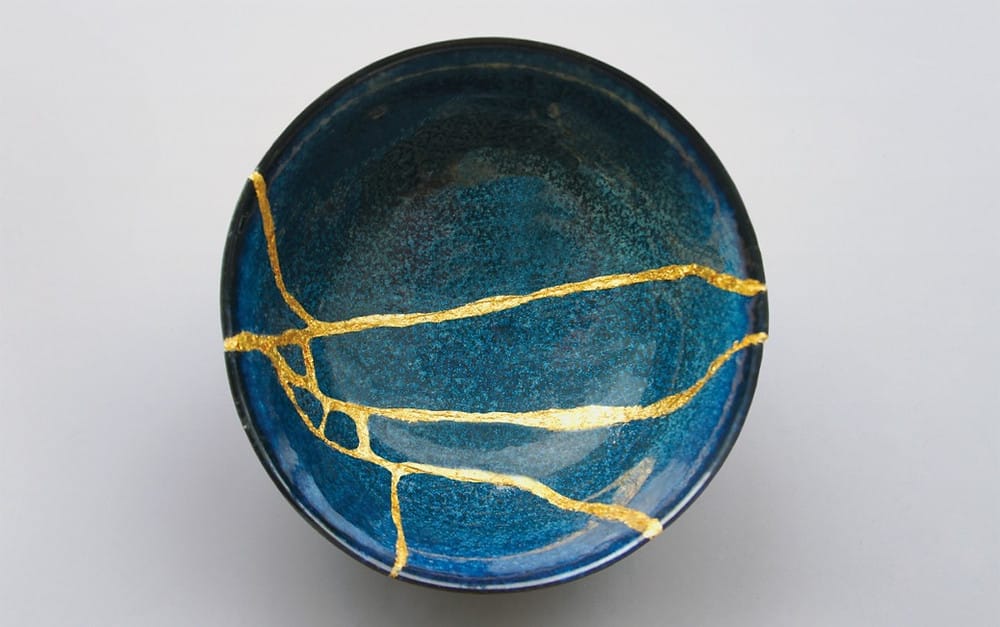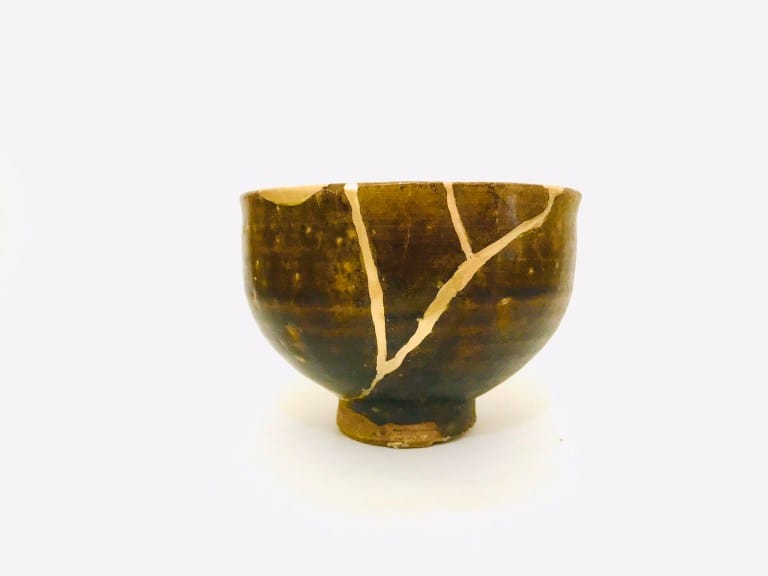This is the second of two posts looking at the art of Makoto Fujimura. In last week's post, I touched on his "theology of making" and his work in the realm of "slow art" as he paints in the Nihonga tradition. This article looks at another area of his creative explorations.

The Beauty of the Broken
In addition to painting on canvas, Makoto Fujimura also explores and teaches the art of Kintsugi, which is connected to the Japanese tea ceremonies that are such an important part of Japanese culture and history. In Kintsugi, broken pieces of pottery are bound back together using seams of gold powder or leaf.
This art form is based in something deeper than mere frugality and practicality, although it is rooted in holding onto things that are cared about. As master Kunio Nakamura says in the video below, after the "Great East Japan Earthquake," of March 11, 2011, his business became extraordinarily busy — "what people wanted to repair was their bowls. After your home's gone, your bowls are all that's left" (from the film Kintsugi © Windrider Bay Area, 2023).
Beyond that, Japanese tradition in art has held that it is the imperfection of things that make them particularly beautiful. This is in contrast to the Western mindset in which perfection is the ideal. So, instead of disguising or hiding fractures, Kintsugi emphasizes them, acknowledging the fact that the fractures happened and then opening up a new way of seeing that brokenness.

In Fujimura's words, the broken pottery that is used in Kintsugi is not just repaired or fixed but transformed into something "more beautiful and more valuable than the original, unbroken vessel."
For Fujimura, this carries imagery and significance that resonates with and illuminates Christian thought and theology. He finds parallels between the pottery that has been welded with gold and the resurrected yet still-scarred body of Jesus. With another Holy Week having just come to a close, and the story of Jesus' death and resurrection fresh in the minds of many, the image of the broken and mended bowl can be particularly powerful. Jesus' body, even in resurrected form, retains the imprints of the trauma he endured. His marked body was not made beautiful by erasing the marks, but by transforming them into something new.
Our lives, too, when transformed through the mercy and love of God, do not reset to some earlier version of ourselves before the breakage happened, but are transformed into something that incorporates the breakage. The broken places are welded with seams of gold that add beauty and strength.
"It is precisely through our brokenness and fissures that God’s grace can shine through, as in the gold that fills fissures in Kintsugi." (from Art + Faith: A Theology of Making, by Makoto Fujimura).
Seeing the whole of creation through this lens can also help us to more fully recognize the beauty in the world. The "New Creation" points not to a discarding of the old, but instead to a transformation of what already exists. It is not a mere fixing or repairing, but a changing into something more beautiful than what it was originally. And in Fujimura's mind, this is what we are to anticipate and work toward.
Having this perspective and belief can change the way we see both the imperfection of the world around us and its beauty. A creation that is worthwhile, open-ended, broken, beautiful, transformed, and loved, can help us cease yearning for what is past and instead help us look toward what will come. This can also lead us to search for God's intent for the creation and our part in that intention. If we are called to be co-creators, we have both an unbelievable privilege and a deep and weighty responsibility to join God in this work of transformation.
Reflection Questions: Have you been part of a work of "mending" that seemed to transform what was being mended into something with greater beauty than it began with? What abilities and gifts have you been given that might be put to use in this work of transformation?
See more work from Makoto Fujimura and find more about his work by visiting his website. Find his writing here and link to a video featuring Fujimura and the art of Kintsugi below.
Feel free to leave a comment below or contact me directly at louise.conner@circlewood.online.
Louise
Want to learn more?
Find out more or support our parent organization by clicking below.